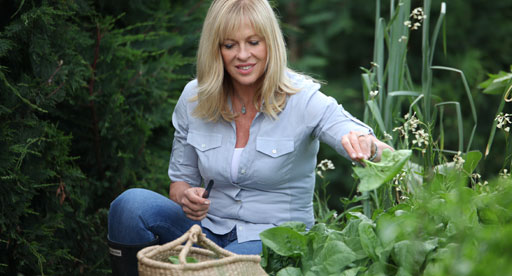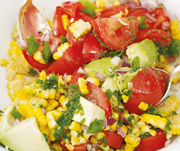
For most of us with a vegetable garden, the growing season starts in spring and runs through to the end of autumn. We tend to forget about winter vegetable gardening, but you can take the same approach as you did back in spring, preparing the ground, sowing seed and planting out seedlings to enjoy harvests through the winter.
Winter gardening is not about leftovers from traditional summer cultivation but crops that enjoy the cooler weather, and often taste sweeter, tenderer and more flavourful with the cold. While tomatoes, eggplants, cucumbers, peppers and other hot-weather vegetable find the cold inhospitable, more than 30 common vegetables can be considered cold-hardy.
Winter stalwarts include spinach, silverbeet, carrots, kale, kohlrabi, coriander, broccoli, cabbage, spring onions, leeks, parsley, beets, swedes and turnips, as well as a range of Asian greens. There are lots of salad greens that enjoy the cold – rocket, lamb’s lettuce or mache, garlic greens, endive, watercress and radicchio to mention but a few. Miners’ lettuce (otherwise known as Claytonia perfoliata or winter purslane) starts coming up wild all over my garden at the end of autumn and grows happily right through the hard frosts of winter. It seems so surprising that this pretty little plant is so hardy as it has such a succulent texture.
It always feels good to cook with what you have at hand rather than buying vegetables. In the same way that a summer garden saves you dollars, so too will a winter one. A winter garden will provide for stir-fries and side dishes as well as all kinds of great salads. Put it together with all the stored vegetable supplies you’re harvesting right now (potatoes, pumpkins, onions shallots and garlic) and you won’t need to go shopping!
The difference between growing veg as the days get shorter and colder rather than longer and warmer is that everything takes more time to grow. Getting quick-growing crops that like the cool, such as spinach, bok choy, radishes and coriander, into the ground in early March will give you a harvest in May before it gets really cold. Plant again towards the end of the month for harvesting later in the winter.
For success with a winter garden you need to get winter crops well established before the ground cools right down and well before any chance of frost.
The first thing to get to grips with is your climate zone. Check out Tui’s great downloadable planting guide to see what’s good to plant in your region.
For crops that will ripen and mature through the winter, the trick I have found works best is to tally the “days to harvest” and then add two extra weeks for the cooler autumn/winter conditions.
For example, broccoli takes 60-80 days from transplanting small seedlings to maturity, depending on the variety. Add two weeks to account for the cooler growing conditions and you get a rough guide that seedlings planted in the first week of March will be ready around late June, early July. Plant one lot of seedlings at the start of the month and another batch in the third week of March and you should be set to enjoy a succession of broccoli harvests right through the cool months.
The risk you run if you leave it too late is that the plants won’t be established enough to mature and will just sit right through winter without putting on any growth, then bolt in early spring without fully maturing. If you have had this happen you will know how frustrating it feels, so March is the cut-off date to get those winter crops into the ground.
The seeds of cut-and-come-again salad greens, such as rocket, corn salad, land cress and oriental greens, will provide a succession of leaves for salads through the autumn and winter if covered with a cloche or frost cloth.
Crops like carrots, beets, parsnips and leeks will happily sit in the ground and slowly mature through the cold of winter, but root vegetables don’t do much growing once the temperature drops so the roots need to be well bulbed up by May for decent winter crops.
It’s really important to get the soil in tip-top shape before you do any autumn planting – in just the same way you did back in spring. Refuel it with compost, sheep pellets, vegetable food and perhaps even some lime, depending on what you are growing. As with any transplanting, give your seedlings a good soak in Seasol seaweed-based plant tonic before you plant them out.
I try to keep up my bed rotations going through winter. Once the tomatoes and potatoes have come out I pop root vegetables into those spaces. Where the corn was I plant brassicas, where the garlic and onions were I plant winter salad greens, spinach and silverbeet.
There is always spare room in the garden in winter, so wherever there is an empty spot I pop in a green manure crop that I can dig in in the spring – mustard is good as it also serves to keep whitefly and wireworm at bay.
Now is also a good time to harvest herbs for winter drying and teas – sage, chamomile, lemon balm, thyme and oregano all dry well. I like to pick whole branches, tie them in bunches and hang them upside down inside a paper bag. When dry, the flower heads or leaves come off easily – it’s so good having your own chamomile tea to sip over the winter, and sage and honey is another good winter combo.
In the meantime I’m making the most of my autumn harvests of corn and tomatoes in salads like my Cobb Salad.
Annabel Langbein's Cobb Salad
This is one of my most popular salad recipes ever – summer in a bowl! To make Chicken Cobb Salad, shred the flesh of 1 cooked chicken or 2 smoked chicken breasts into the salad for a main course.
Prep time: 10 mins
Serves: 4
Ingredients
- 1½ cups whole kernel corn, cooked, or thawed if frozen
- 4 tomatoes, cored and cut in wedges
- 1 large just-ripe avocado, cut in chunks
- 2 tbsp finely chopped red onion
- 2 spring onions, thinly sliced
- ½ tsp salt
- ground black pepper
- ¼ cup Basil Oil (see below for recipe)
Basil Oil (makes 1½ cups)
- 2 packed cups (60g) basil leaves
- ½ tsp salt
- 1 cup oil, such as olive oil or grapeseed oil or a mix of both
Place basil leaves in a bowl and cover with boiling water to wilt. Drain at once and refresh under cold water. Drain thoroughly and purée with salt and oil until smooth. Strain off solids through a fine sieve if desired. Keep in the fridge up to 4–5 days or freeze in ice block containers.
Method
Toss all ingredients together and season to taste. Prepared salad can be stored in the fridge for up to 2 hours.For longer storage add the avocado at serving time. Return to room temperature before serving.
Post a comment
Annabel Langbein's Autumn Garden Comments
Looks wonderful and fresh. Looking forward to making and tasting
Kathryn Lilley
Cobb salad sounds amazing will make it tonight.
JEANIE
Cobb salad on the menu for the weekend!
Maggie
Thanks for the planting guide,excellent reference tool!
Maggie
I am not a gardener at all, well I'm ok with flowers but not veges etc. I love the seasons chart for when I can plant and what I can plant. I'm going to give it a go and see how I get on thanks very much.
Diane Jones
I've made this salad for countless bbqs over the last couple of years. Always a favourite with everyone and I've handed out the recipe too many times to count as a result. Made exactly as the recipe says, it's amazing.
Kate